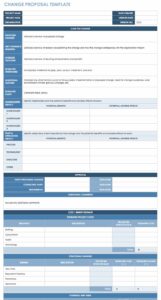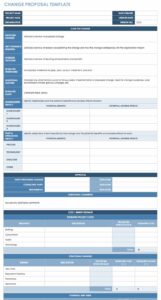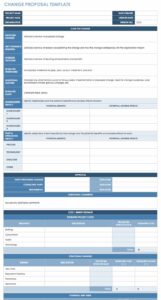Utilizing a formalized structure for modification proposals offers several advantages. It promotes consistency in documenting requested changes, reduces ambiguity and miscommunication, and streamlines the approval process. This, in turn, contributes to better project management, improved product quality, and reduced development costs.
The following sections delve deeper into the essential components of such forms, best practices for their implementation, and common challenges organizations face when managing these processes effectively.
Key Components of a Change Request Form
Effective management of modifications requires a structured approach. Essential components of a standardized form ensure clarity and traceability throughout the process.
1. Unique Identifier: A unique number or code assigned to each request allows for easy tracking and referencing.
2. Requestor Information: Details of the individual or team initiating the change, including name, role, and contact information.
3. Date of Request: Timestamping the submission provides context and helps monitor the progress of the request.
4. Description of Change: A clear and concise explanation of the desired modification, including the rationale and expected outcome.
5. Impact Assessment: Analysis of the potential effects of the change on the project scope, timeline, resources, and other related systems.
6. Priority Level: Categorizing the request based on urgency and business impact facilitates efficient allocation of resources.
7. Proposed Solution: A suggested approach or implementation details for the requested modification.
8. Approval Status: Tracking the authorization process, including relevant stakeholders’ approvals or rejections.
These elements contribute to a comprehensive record of each modification, enabling informed decision-making and efficient implementation.
How to Create a Change Request Template
Creating a standardized form requires careful consideration of various factors to ensure its effectiveness in managing modifications throughout the software development lifecycle. The following steps outline a structured approach to developing such a template.
1. Define Objectives: Clearly outline the purpose and goals of the form. This includes identifying the types of changes it will cover and the stakeholders involved.
2. Determine Essential Fields: Select the key information required for each request. This typically includes a unique identifier, requestor details, date, description of the change, impact assessment, priority level, proposed solution, and approval status.
3. Design the Layout: Structure the form logically to facilitate easy completion and review. Group related fields together and use clear labels for each section.
4. Choose a Format: Select a suitable format, such as a digital document or spreadsheet, based on organizational needs and accessibility requirements. Consider using a dedicated change management system for more complex projects.
5. Establish a Workflow: Define the process for submitting, reviewing, and approving change requests. This includes identifying the relevant stakeholders and their roles in the approval process.
6. Implement and Train: Introduce the template to the development team and provide training on its proper use. Ensure all stakeholders understand the importance of adhering to the established process.
7. Regularly Review and Refine: Periodically assess the effectiveness of the template and make necessary adjustments based on feedback and evolving project needs. This continuous improvement ensures the template remains relevant and efficient.
A well-designed template provides a standardized framework for managing modifications, enabling clear communication, streamlined processes, and better control over project scope and deliverables. Regular review and adaptation are essential for maintaining its effectiveness within a dynamic development environment.
Standardized forms for documenting modifications in software development provide a critical mechanism for managing project scope, ensuring clear communication, and maintaining product quality. From initial request through approval and implementation, these structured processes offer significant benefits in terms of traceability, accountability, and efficient resource allocation. Key elements such as unique identifiers, detailed descriptions, impact assessments, and defined approval workflows contribute to a robust system for handling evolving requirements throughout the development lifecycle.
Effective change management is essential for successful software project delivery. Organizations that prioritize the implementation and consistent use of well-designed change request processes are better positioned to navigate the complexities of software development, minimize risks, and ultimately deliver high-quality products that meet evolving business needs.


